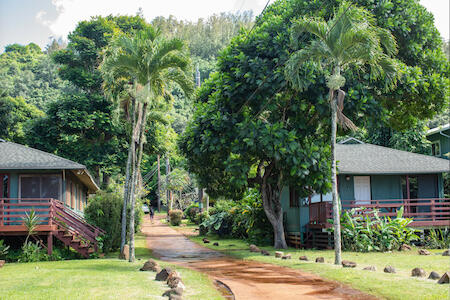Looking for budget stays in Oahu? This section is designed to save you time, money, and unnecessary stress. We've got insider tips to help you find affordable hostels and the cheapest places to stay in Oahu.
Oahu, properly spelled O’ahu, is affectionately called "The Gathering Place" by locals. The third-largest of the Hawaiian Islands (and home to the state's capital, Honolulu), it is also one of the most densely populated areas throughout the whole of the Hawaiian archipelago. Roughly divided into regions -- the City, the Town, the North Shore, the Windward Side, the East Side, and the Valley -- Oahu is a great place to vacation in Hawaii (if you’re planning on staying here, there are several options for hostels in Oahu with differing atmospheres and settings). Not only is the island rich in history and culture, but it is also a hotbed of life with the right mix of down-to-earth local fun and wonderful "high-life" style parties that appeal to more affluent tourists.
The island's many notable historical places, such as Pearl Harbor, make it a prime tourist destination. Here you can pay tribute to the victims of the 1941 bombing and also learn about its early history as a naval and aerial base, and be witness to the history of World War II aviation. If you’re more daring, you can even take an open-cockpit flight and see things from up high. For those who want the full immersion, boarding a period combat submarine is also up for grabs!
Visitors also come to see its rich natural wonders, which are typically comprised of volcanic formations, rocky outcrops, verdant fields, and small inlets of water that are interlinked with the vast ocean. Oahu is home to a peak -- Mount Ka’ala, a mountain rising to the highest point of the whole island, more than four thousand feet -- found in the Wai’anae Range.
Oahu is also home to a diverse range of ethnicities, ranging from native inhabitants, pure descendants, intermixed descendants, and settlers all of which refer to themselves as locals, regardless of their ancestry or place of origin (as is customary in the whole of the Hawaiian islands), as a nod to unity in the light of diversity and the openness of the islands to welcome all peoples to its collective embrace. Known as the original seat of aboriginal Hawaiian aristocracy, it was once ruled by the earliest kings of Hawaii.
Haleiwa, North of Oahu
Haleiwa, on the island of Oahu, is a great place to surf, swim, or just relax on the beach. Adventurous travelers can take an air tour on a small aircraft, skydive, or hang glide over the ocean. Walking tours that showcase the waterfalls and gardens and horseback-riding tours through the tropical rainforest are a couple of other ways to explore the area.
The many beaches in Haleiwa offer a variety of recreational opportunities. Waialua Bay is excellent for scuba diving while Shark’s Cove is best for snorkeling and diving. There is a scenic swimming hole in front of the waterfall at Waimea Falls and tons of surf schools along the shores. In the winter, surfing competitions are held on the North Shore beaches, where the waves can be as high as thirty feet. Whale-watchers will also enjoy the winter months. The temperatures in Haleiwa are moderate even in the summer and winter, but there are many rainy days throughout the year.
Hostels in Haleiwa are located on or near the beach and there are several from which to choose. The hostels offer dorm rooms, private rooms, and tents (tents and larger dorms are the least expensive options). Haleiwa hostel amenities can include bike and surfboard rentals, snorkeling equipment, boogie boards, and gyms.
There are many restaurants along the Kamehameha Highway; local cuisine consists of Hawaiian dishes such as Kalula pig, poke (a type of raw fish), pipikaula (similar to smoked beef or jerky), haupia (a coconut milk pudding), saimin (a type of soup with noodles), and mahimahi.
Written by Travel Expert Oahu
 Angelica Burrage
Angelica Burrage